National Data
“I wish that teachers could receive feedback on a regular basis that was a narrative of what we are doing well and where we need to grow.”
— MIDDLE SCHOOL TEACHER
Teachers Find Evaluations Most Helpful When They Include Actionable Feedback and Multiple Measures
- Sixty-nine percent (69%) of teachers say they receive feedback from their formal evaluation to help refine or improve their teaching practice
- More than eight in 10 (83%) teachers whose evaluations include three or more metrics say their evaluations are at least somewhat helpful in refining or improving their teaching practice
- Teachers who do not find their evaluations very or extremely helpful share that they desire more actionable feedback (42%), increased fairness in the evaluation process (30%) and more—and better-qualified—evaluators and observers (23%)
MOST TEACHERS ARE EVALUATED AT LEAST ANNUALLY, WITH THOSE EVALUATED THE LEAST OFTEN MOST LIKELY TO WANT MORE FREQUENT EVALUATIONS
Eight in ten (79%) teachers say they receive an evaluation at least once a year and nearly all (99%) teachers say they are evaluated at least once every few years.
Frequency With Which Teachers Report They Receive Formal Evaluations, in Total and by Years of Teaching Experience
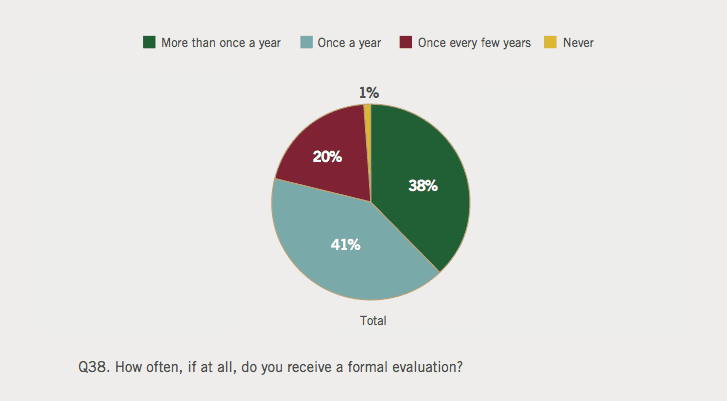
Base: Total Respondents. Details: page 64 in the full report. State data here.
While a majority (59%) of teachers are satisfied with how often they are evaluated, many teachers feel they ought to be evaluated more often. For example:
- Among teachers who are evaluated once a year, 21% indicate they should be evaluated more often.
- Among teachers who are evaluated once every few years, 38% indicate they should be evaluated more often.
- Among the very few teachers who are not evaluated at all (1%), almost all (93%) say they ought to be evaluated.
More information on the transitions to new evaluations systems and overall frequency of teacher evaluations—including a subgroup analysis by years of teaching experience—is available in the full report.
Most Teachers Receive Feedback from Evaluations but few receive customized supports to Improve or Refine their Practice
Teacher evaluations result in various outcomes, the most common of which is feedback from the evaluation for the purpose of helping teachers refine or improve their practice (69%). Few teachers, however, report that professional support beyond feedback stems from their evaluations.
Percentage of Teachers for Whom Each Situation Applies as a Result of Formal Evaluations
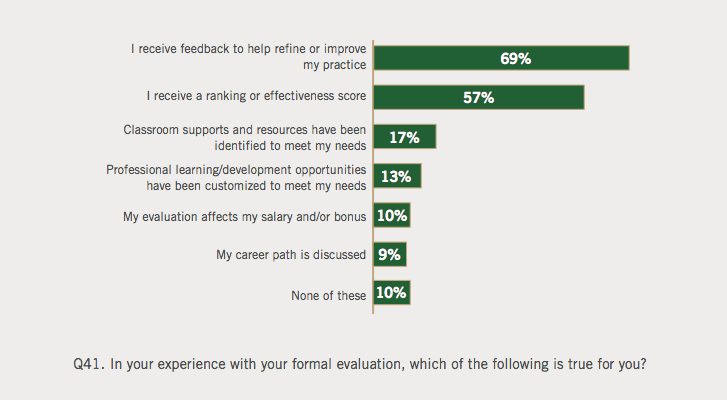
Base: Receive a Formal Evaluation at Least Once Every Few Years. Details: page 66 in the full report. State data here.
Additional information on the outcomes of formal evaluations—including subgroup analysis by years of teaching experience and degree of helpfulness—is available in the full report.
Actionable feedback is critical to ensure evaluations improve teaching
Nearly four in five (78%) teachers say their evaluations are at least somewhat helpful, although just 21% say they are very helpful and 8% say they are extremely helpful. One in five (22%) says their evaluations are not at all helpful.
Teachers’ Views on the Overall Helpfulness of Their Formal Evaluations in Refining or Improving Their Teaching Practice, in Total and by Years of Teaching Experience
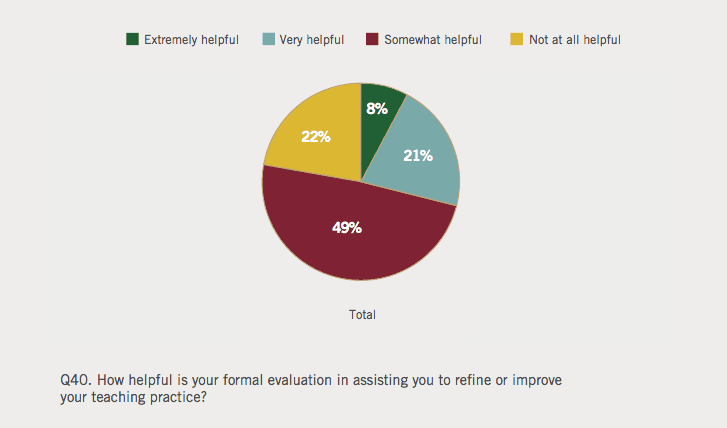
Base: Receive a Formal Evaluation at Least Once Every Few Years. Details: page 68 in the full report. State data here.
Teachers who reported their evaluations are not at all helpful or are only somewhat helpful were asked to share the types of changes they would make to improve their evaluation to make it more helpful. Three main themes emerged:
- Desire for more feedback, especially personalized feedback – Teachers’ comments included suggestions such as: providing constructive criticism to help teachers improve; providing concrete examples of issues arising during observations; and providing immediate feedback to allow for a conversation to occur soon after the evaluation.
- Desire for increased fairness in evaluations – Teachers’ comments included suggestions such as: evaluators visiting the classroom more often and for longer periods of time to “really see my teaching”; using unbiased evaluators from outside the school; making evaluations less punitive; and increasing focus on student involvement and growth over student test scores.
- Desire for more qualified evaluators – Teachers’ comments included suggestions such as: ensure school leaders and evaluators “understand the curriculum for my content area”; use evaluators with classroom experience and knowledge of best practices; and allow for additional input from peers, students and self-assessment.
Teachers’ Views on Changes That Would Make Formal Evaluations More Helpful (Open-ended Responses, Coded and Combined into Themes)

Base: Receive a Formal Evaluation and Think Evaluation Is Somewhat or Not At All Helpful in Refining or Improving Teaching Practice.
Details: page 69 in the full report. State data here.
More information on teachers’ views on helpfulness of their evaluations and desired changes— including subgroup analysis by years of teaching experience— is available in the full report.
THE MOST HELPFUL EVALUATIONS INCLUDE A WIDE VARIETY OF MEASURES OF TEACHER PERFORMANCE
While observations are by far the most common components of teachers’ evaluations—nearly all (96%) teachers say they are observed—many teachers report additional measures included in their formal reviews.
Components of Teachers’ Formal Evaluations
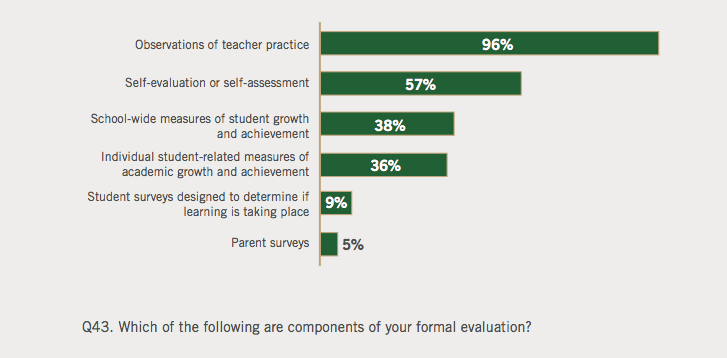
Base: Receive a Formal Evaluation at Least Once Every Few Years. Details: page 72 in the full report. State data here.
- Eighty-three percent (83%) of teachers with three or more metrics in their evaluations say their evaluations are at least somewhat helpful, versus 74% of those with fewer than three components.
- Thirty-six percent (36%) of teachers whose evaluations include three or more metrics say their evaluations are extremely or very helpful, versus 25% of teachers whose evaluations include fewer than three metrics.
- Among the 5% of teachers who are evaluated on five or more metrics, the percent who say their evaluations are extremely or very helpful rises to 44%—a 76% increase compared to teachers with fewer than three metrics.
Teachers’ Views on the Overall Helpfulness of Their Formal Evaluations in Refining or Improving Their Teaching Practice, by Number of Components in Teachers’ Evaluation
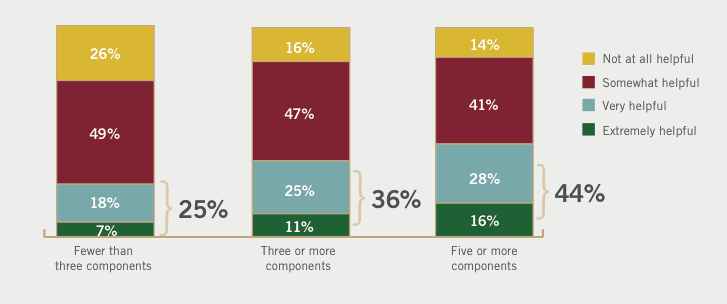
Base: Receive a Formal Evaluation at Least Once Every Few Years. Details: page 87 in the full report. State data here.
Additional data on the components of teachers’ formal evaluations—including a subgroup analysis by type of evaluation system (new or old) and helpfulness—are available in the full report. [Link the words “full report” to full report] You will also find a more in-depth look at observations of teacher practice, including frequency, helpfulness, personnel involved and subgroup analysis.
MANY TEACHERS SAY OBSERVATIONS OUTSIDE OF EVALUATIONS SHOULD LEAD TO ONGOING FEEDBACK TO REFINE AND IMPROVE THEIR PRACTICE
Observations outside of formal evaluations can supplement and complement the feedback teachers receive. Nearly three-quarters (73%) of teachers are observed outside of a formal evaluation system and a majority (86%) receive feedback based on these observations.
Many teachers do not think they receive feedback from observations outside of evaluations as often as they should. Thirty-seven percent (37%) do not receive feedback from these observations at all, but 97% say they should. Note that the 37% who “never” receive feedback includes the 27% who are not observed outside of evaluations, plus the teachers who are observed but do not receive feedback.
Comparison of How Often Teachers Report They Receive Feedback from Observations That Are Not Part of Formal Evaluations With How Often They Believe They Should
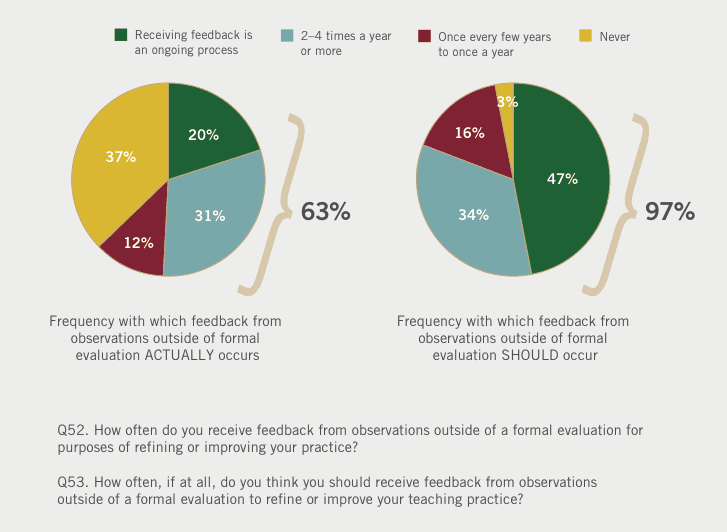
Base: Total Respondents. Details: page 84 in the full report. State data here.
Additional information on the student-focused metrics used as part of teachers’ formal evaluations, as well as teachers’ views on the most accurate measures of student performance, is available in the full report.